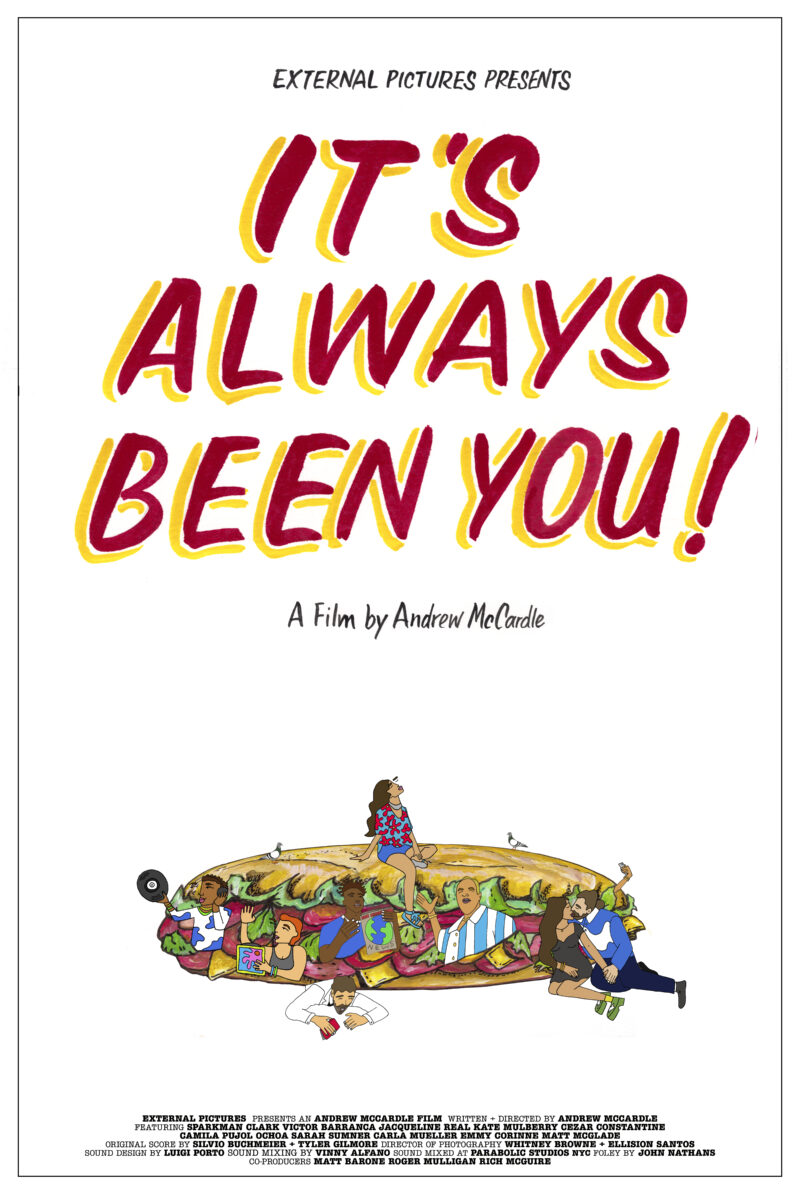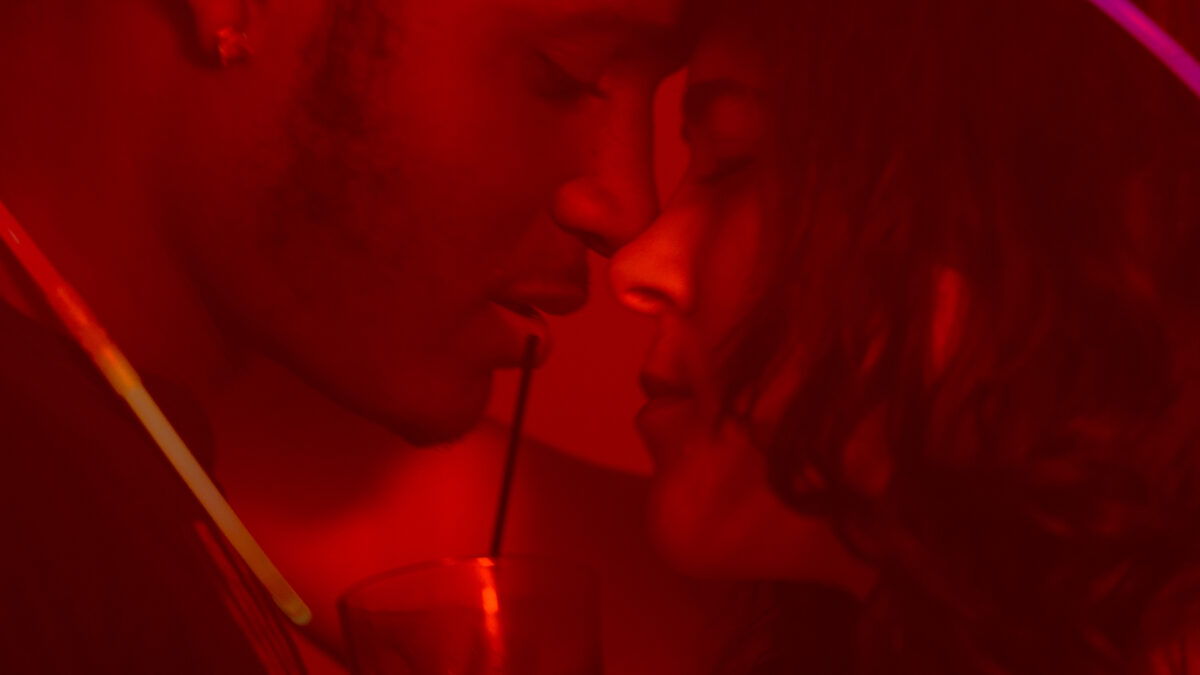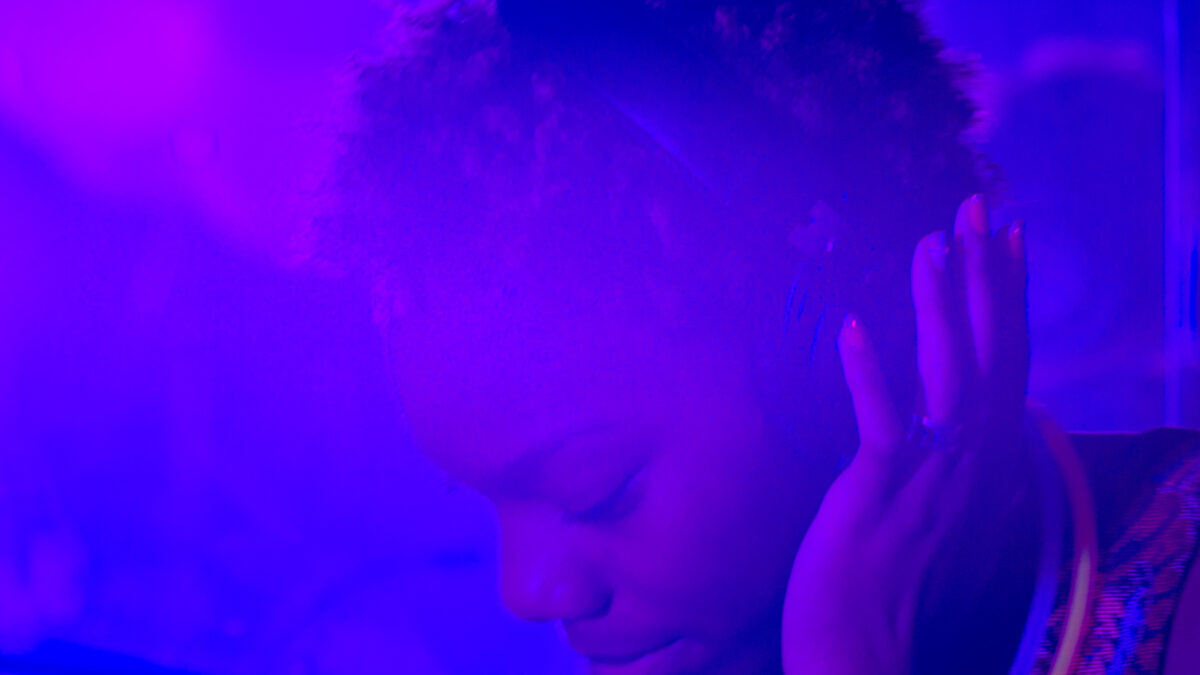One of the most unusual independent films of 2020, which makes it all the more intriguing and watchable, is Andrew Mccardle’s experimental cinematic collage IT’S ALWAYS BEEN YOU!.
The film takes the nature of cosmic existence and transposes it to modern-day Brooklyn, as a community of characters, all of whom seem to step in and out of the others’ own space and time, coupled with a long-dead bride’s own reflections on where she is – and perhaps was.
Intellectual challenging and questioning in equal measure, the film is generating considerable buzz on festival radars – and Film And TV Now was delighted to speak with the director about his work.
FILM AND TV NOW: You have used a very unconventional narrative concept to tell your story here, focusing on many characters rather than the traditional one or two. Tell us how the script and story evolved from conception.
ANDREW MCCARDLE: In the beginning I think the script evolved from the feeling in New York and the US in general at the outset of 2016, the atmosphere felt tense and I think in some way, ready to boil over, it’s fertile ground for cinema because I think cinema is most effective with a very pronounced sense of atmosphere.
Having no central character of focus was very integral from the start, I think it had a lot to do with trying to capture the spirit of the time in that moment and for nothing to distract from the feeling of time passing. It also allows us to experience the omniscience of the Lola Montez character presiding over the story, so that no character’s point-of-view dominates over the film. Each person on screen, whether for several minutes or several seconds, even time itself, the neighborhood, the pigeons, these are all characters in the tapestry.
FTVN: Stanley Kubrick did a similar thing in 2001 – A SPACE ODYSSEY, using a rather left-field protagonist in the monolith to move the story on. Here it is a long-deceased bride looking down on the citizens of New York. Who were your key cinematic influences when putting this film together?
AM: I think in your wonderfully written and thoughtful review of the film you hit the nail on the head with influential works, and the monolith as a representational thought-form, much like Lola Montez’s role in this film.
The real-life Lola is, of course, buried in Greenwood Cemetery where we filmed, though here she is also a cinematic memory from the Ophuls film which I love, just as much as she is a true memory. I find the primary gurus of cinema who light the way today to be people like Godard and Lynch who truly create their own syntax (and theirs stems from Vertov and Murnau), Lee and especially Do the Right Thing were massively influential.
I think I had the cast watch three films before we got into filming and we all got together at Caravaglia Studio in Union Square to screen Altman’s Nashville, Burnett’s Killer of Sheep and Lee’s Do the Right Thing. Killer of Sheep especially its use of actors from Burnett’s neighborhood, the way he uses music and constructs the ensemble were hugely influential, I don’t think my film captures the intimacy that he was able to though, which is his film’s greatest strength.

FTVN: Tell us about your cast.
AM: A beautiful combination of those who answered neighborhood calls for casting sessions and people who live on these streets.
Sparkman Clark and Victor Barranca brought what I think is the film’s signature scene to life as they wax philosophical on the streets of Park Slope and browse a record shop. They bring so much of the personality to the film overall. Sparkman is one of the hardest working people from writing to directing, to being in front of the camera, just massive amounts of respect for her.
Matt McGlade, I think anyone who sees the film will agree, is unforgettable as a man ranting to anyone who’ll listen, activist and evangelist for any thought that seems to enter his head. So much of the character, from costume and beyond, is his creation and he really disappears into the part.
Our three silent characters who represent each of the three dimensions of the film were of course Kate Mulberry as the aetherial Lola Montez, Jacqueline Real as the material plane of Earth and Emmy Corinne as the digital plane. They each bear witness and ‘see’ during the film, they react but never speak. It’s difficult to connect with the audience without dialogue but their physical performances I think resonate so deeply.
Camila Pujol Ochoa and Cezar Constantine knock it out of the park as a couple dating in the cemetery, their energy brings us into another world. Peter Napolitano, one of the best minds in Brooklyn and a brilliant modern day philosopher sets the stage with a cameo during the opening sequence at Lioni Italian Heroes in Bensonhurst.
FTVN: Tell us about your production team.
AM: So many friends and colleagues came to the rescue on this one, above all the producer Matt Barone and actor/producer Roger Mulligan who were massively instrumental, it can’t be overstated.
At times the crew consisted of many people and at times the crew was literally the three of us and those ‘skeleton crew’ sequences are honestly some of the best. They gave it their all and deserve all the credit in the world on this one. I’ve never met someone so knowledgeable on history and philosophy in general, and especially New York history, as Richard McGuire who produced many of the film’s shoots and on into post as well, it could not have been made without his involvement. Any time I wanted to know if something would work I would run it by Rich and there I had my answer.
Then there is Whitney Browne, love of my life, who provided so much of the visual atmosphere to the moodier sequences shot later, much of the naturalistic sequences Ellison Santos oversaw as DP and they both did brilliant work. Having different members of the production team oversee different reels depending on tone continued on into post where two different composers brought us into wildly different worlds.
Silvio Buchmeier composed and conducted the live instrumentals, the sounds of scenes of life in Brooklyn, that dance of reality as Jodorowsky puts it. Tyler Gilmore provides the electronic score as we leave that plane of reality for a new digital frontier. The way the two fit together amazes me and each score is incredibly strong on its own.
The sound design is what really allows the film to sing in my opinion, and sound designer Luigi Porto transformed the film and it truly came alive with his work, what Luigi did here was to give the film its voice. John Nathans created many original sounds and Vinny Alfano oversaw the rest of post sound and fully mixed the film.
He was with us almost a year in post and guided the process every step of the way, his contribution to the film can’t be overstated.
FTVN: New York remains a considered location and you use some interesting angles to show the city from a cinematic perspective. What is it about the city that you both like and dislike?
AM: For me it’s hard not to love New York, even now when much of the city has been closed for Covid it’s still inspiring to see the way New Yorkers will make the most of the situation, expressing themselves and conducting business any way they can.
The New York I miss is what’s depicted in the film, a dance of life with streets teeming with activity, small hidden enclaves away from it all, a quiet spot in the park, a record shop, always feeling like you could stumble into a completely hidden world on the next block.
I think anyone in this city knows the feeling of walking down the sidewalk and feeling bits and pieces of everyone’s life, anything could be going on, maybe they lost a loved one, maybe they just fell in love, maybe they lost their job, maybe they just ate the best sandwich they ever had, who knows.
You experience it with them for a second (or maybe several seconds if you’re in the same train car) and then it’s on the next thing, the next block, the next train. That’s New York in my mind, shared moments, however brief, that become meaningful.

FTVN: There are references to the political and social climate in the film as we follow the characters, specifically during the key Brooklyn sequences. Was this something you wanted to incorporate into the film, or was it purely a visual objective?
AM: To capture that spirit of the times I had to turn to Debord’s concept of the Spectacle, and now more than ever we live in Spectacular Time where each day brings a new phenomena that is subsequently discarded the next day (or minute) for a new “never-before-seen” phenomena.
Yet this political and social climate you’re speaking of keeps the characters in the film firmly in its grip the entire time, almost hypnotically, drawing their attention toward a few topics of the day they all seem preoccupied with. I see the film as partially a time capsule and wanted to capture as much of the feeling of 2016 as possible, as time goes on I’ll know if I was successful or not.
In Debord’s definition the process of production with its false, near-constant ”improvements” are not reflected in our consumption, which constitutes an ‘extended repetition of the past’. Cinema is this in itself, a constant repetition of the past as well, the past moment dominates the present moment.
If this is truly illusorily lived time, it becomes important to represent both the natural flow of real-time with several long unbroken takes of actual time passing, as well as the illusion of compressed spectacular time with many scenes comprised entirely of quick cuts and montage.
FTVN: The tone of the film shifts, albeit briefly, at one point with the sniper on top of the roof taking aim at some partygoers. Was incorporating a violent moment part of the original intention and was it something you thought carefully about, considering the climate in the USA over gun-related incidents and inner-city violence?
AM: I see the film as a descent rather than having any sort of arc and so for the final reel we have fully entered a digital dreamscape which in turn becomes a kind of nightmare.
I think in daily life in 2016 in New York we were all feeling reminded constantly of the ever-present possibility (and often very real) eruptions of this kind of mass violence, it becomes a paranoia that exists on the fringes of the mind, and that was where I wanted to travel for the film’s final act, the fringes.
As we ripple outward we end the film in a place of full surrealism completely removed from reality. It felt fitting to include these kinds of thoughts in the tapestry and not disregard them. It also felt important that the shadowy figure committing the act is someone we’ve seen previously as a part of the neighborhood. I hesitate to reveal who, but they’re in there.

FTVN: What themes would you like to explore in the future?
AM: In the film a character asks about the nature of human existence and I think these topics will continue to draw my attention; the nature of reality, the nature of cinema, where they intersect. The seeds are planted in It’s Always Been You! And now they can grow into subsequent films.
The film is its own reality, and I’m very interested in how it can communicate a state of mind or a state of being through the time we spend with it. It’s a hypnotic dream-state that the audience enters when they shut out all distraction, enter the dark theater and become immersed in the screen, in this way it’s the perfect medium to communicate the subconscious, directly speaking to the subconscious of the audience.
Dream-scapes and thought-forms flow freely in this medium and we can express in a deeper sense than our other modes of communication. I think when making films, and hopefully the audience agrees, it is more beneficial to meditate on a subject that the filmmaker comes to know through the process of making the film, to focus on a question as the central theme and through the interaction between the film-maker and the audience the question is considered deeper, at least we can hope.
FTVN: How has the film been received overall by audiences and festivals?
AM: I feel overjoyed that it has been largely received in the spirit it was given, as a passionate dream and a reminder of what exists beyond us. It’s sparked plenty of conversation with those who’ve seen it, as they say they are contemplating life and death and everything in between.
That it is such an existential experience for people is deeply gratifying. I think we live daily in touch with a finite mindset and the best art reminds us of eternity, I hope that is what anyone who sees the film leaves the screening with.
FTVN: What did you shoot the film on?
AM: We shot digitally, and my aim was that the film have a warm, almost technicolor feeling to it. Rather than hire out for this I decided to lose the sleep myself and color the film, which turned out to be a real joy to be honest. I got very lost in the process of giving the film its color palette and love the way it turned out.
FTVN: How long did it take to shoot and how did you raise finance?
AM: We began shooting in mid-June 2016. I started a production company, External Pictures, in March of 2016 to create content and that revenue is what funded the film entirely. We were incredibly micro-budget but it allowed for maximum expression.
It made our timeline quite long, we filmed as much as we could in the warm months of the year, then waited until the following summer 2017 to shoot a few key scenes that remained. The film’s final sequence in the restaurant (in this case Villa Mosconi in Manhattan opened their doors to us and we’re grateful they did, it was the perfect location.) was filmed December 2017 almost 18 months after the first scene rolled.
Post took about the same, with the sound design and score taking a full year unto themselves but well worth it.
FTVN: How has COVID-19 affected you as an artist and film-maker?
AM: It hasn’t slowed the pace, we’re creating content with remote filming over video conferencing and as you can guess I’m obsessively watching Criterion Channel when I’m not working.
It’s given time to put the finishing touches on two scripts I’ve been writing since before the cameras even rolled on It’s Always Been You! And I’m very thrilled to see them in a good place. I’ve also begun assembling a feature to experiment with some materials filmed before Covid and very excited to see where it goes, I’ve been cutting off and on for the last couple of months.
FTVN: Finally, what are you most proud of about the film?
AM: I think I’m most proud of its blending, the way that the talents of so many are able to come together, the various approaches to acting style, to music style, to planes and dimensions of reality within the narrative.
A large part of the goal was to feel as though the viewer can be everywhere at once at various moments, both in space and time, and I think the way the film blends into these various worlds is a thing of beauty. The film is like a child and to see its completion is akin to its graduation, now it begins a new life out in the world and like a proud parent I couldn’t be happier.





























